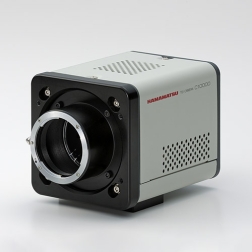Building on their extensive experience with high performance scientific cameras and advanced imaging applications, Hamamatsu introduces the new ORCA-Flash4.0 V3. This one camera expertly handles applications ranging from the acquisition of beautiful scientific images to experiments that demand detection, quantification and speed. With on-board FPGA processing enabling intelligent data reduction, highly refined in-camera, pixel-level calibrations, increased USB3.0 frame rates, purposeful and innovative triggering capabilities, patented lightsheet read out modes, and individual camera noise characterisation the ORCA-Flash4.0 V3 is the precision instrument for imaging.
Calibrated for Quantitative Accuracy
The ORCA-Flash4.0 cameras have always provided the advantage of low camera noise. In quantitative applications, like single molecule imaging and super resolution microscopy imaging, fully understanding camera noise is also important. Every ORCA-Flash4.0 V3 is carefully calibrated… as a precision instrument must be. Hamamatsu’s attention to this detail delivers outstanding linearity, especially at low light, and offers improved photo response non-uniformity (PRNU) and dark signal non-uniformity (DSNU) to minimise pixel differences and reduce fixed pattern noise. Each camera ships with a certificate providing the read noise and photoelectron conversion factor specific for that camera.
Flexibility for Customized Data Control
Like its predecessors, each ORCA-Flash4.0 V3 is capable of both USB 3.0 or Camera Link output. In addition, the ORCAFlash4.0 V3 offers data reduction through user-controllable look up tables (LUT) for 12 or 8-bit output. These two choices, combined with region of interest selection enable you to fine tune acquisition speed and image data requirements.

Patented Tools for Advanced Imaging
The ORCA-Flash4.0 V3 includes our now patented, Lightsheet Readout Mode which takes advantage of sCMOS rolling shutter readout to enhance the quality of lightsheet images.
When paired with the W-VIEW GEMINI image splitting optics, a single ORCA-Flash4.0 V3 camera becomes a powerful dual wavelength imaging device. In “W-VIEW Mode,” each half of the sensor can be exposed independently, facilitating balanced dual color imaging with a single camera. And this feature can be combined with the new and patented “Dual Lightsheet Mode” making simultaneous dual wavelength lightsheet microscopy a reality. And finally, the ORCA-Flash4.0 V3 is the perfect complement to the new W-VIEW GEMINI-2C dual camera, super resolution-quality, image splitting optics.
Focus on the Relevant Data
The new “Enhanced Visualization Mode” was designed to help answer the question “Can I see it?” Many low light experiments, especially those that were previously imaged using EM-CCDs are now routinely accomplished—with better signal to noise, faster speeds and at far less expense—by sCMOS cameras. However, we sometimes miss the visual punchiness of EM-CCD images. Enhanced Visualization Mode pops the contrast of the displayed image, while
saving the sCMOS raw image data to disk.
And sometimes our innate tendency to seek contrast can be a distraction. Even a few hot pixels in a time lapse or tracking experiment can divert our attention or our analysis from the real data. Enter our multi-level, user-selectable, hot pixel reduction. By applying a series of increasingly aggressive algorithms to detect noisy pixels, you can choose to eliminate these small but distracting elements. And since nobody appreciates having their data unexpectedly modified, the default setting for this hot pixel correction is off when you power up the camera.
Powerful Triggering for Synchronization
Joining a full complement of sophisticated triggering routines, the new Master Pulse timing generator allows the ORCA-Flash4.0 V3 to truly run the experiment. Performing functions that previously would have required an external pulse generator the ORCA-Flash4.0 V3’s Master Pulse has flexible timing delays built in. Powerful synchronization of multiple cameras and devices just became a lot simpler.


PC requirements
With the introduction of the ORCA-Flash4.0, users are now able to stream 4 megapixel images to their computers 100 frames per second. The computer requirements for this high data rate can be met by using the guidelines listed in the downloads section of this page.




































